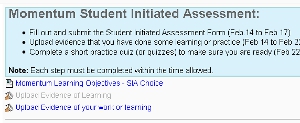Term 2 SBG
L’histoire
After Term I had ended last fall, I was exhausted and extremely disappointed with my students’ reaction to my re-assessment policy. Since I had used the same system the year before, I wasn’t anticipating a different reaction this year. Different year, different students and things didn’t turn out the way I had hoped.
The Experiment
During Term II I was telling my students that I was no longer doing re-assessments. I explained that the results were poor and so was the behaviour around the testing. Too many students begged or complained about them, and clearly too many students didn’t prepare for the re-assessments they signed up for. However, it’s impossible (in my eyes) to run an SBG scheme without re-assessments. So over the past few weeks I designed a few policies for Term II.
I decided to try out two experiments for Term II. First, for the unit on Energy I allowed students to sign up for a SIA. However, the testing would take place at the same time in class as another test (Equilibrium). This was done to get rid of the helter-skelter after-school test bonanza that happened in T1. The 2nd experiment was more interesting. I let students do SIA for the Momentum unit, but they had a series of tasks to complete with a certain timeframe in order to do the test questions. I set up a schedule where the students had to submit the SIA form, then upload evidence of learning, and then finally do an online quiz. For the most part, these tasks were taken care of from with my Moodle course.

I must admit that I took a reasonable amount of amusement in that over half of my students that wanted to do an SIA missed a deadline. Don’t get me wrong, I want my students to succeed but SIA is a privilege and not a right - I think there is great value in holding such a task to reasonable deadlines and conditions.
With the grade 11’s I was a lot more flexible but I’m also sure the test results will not be great. It was obvious that many students crammed the night before.
Path Forward
Where does all of this leave us for the rest of this year? While I like the setup of the Moodle plan and the way it forces kids to approach the SIA in a graduated manner, it does make more work for me. One appealing idea is to set aside one day a week for testing, such as Carolyn Durley does. My fear is that I will end up with 60 kids wanting to do a test every week. I suppose I could try it.
PoL SBG Scheme
In a nut shell, here are the nuts and bolts of my grading scheme.
- I give out shorter quizzes and generally avoid unit tests
- There are no differences between quiz or tests, quiz questions or test questions
- Quizzes have any where from 1 to 5 learning objectives on them
- Each quiz is graded according to objectives, not marks
- Each objective is graded out of 3: 1 is a start, 2 means some understanding is shown (any amount really), 3 means mastery
- Standards are split into 2 categories: A and B. They have equal weight
- A standards are more basic understandings, and allow for some flexibility or small “clerical” errors.
- B standards generally have to be completely correct
- Quizzes usually have multiple questions which address the same objective, but they all count towards one grade for the objective on that assessment
- Students often grade/correct their own quizzes - the 3 point scale makes grading very easy. Almost everything is either a two or three. I look through their quizzes and give feedback when needed.
- Overall grade calculations incorporates some voodoo. I try to set some base level, such as all 2’s results in something like a 68%, and the # of 3’s scales the grade up to 100%. I believe Marzano would consider this to be conjunctive grading.
- Philosophically: any objective can be assessed at any time after evidence of learning is shown. Realistically: as mentioned above, other rules must be put in place
- Students keep all their assessments in a duotang, along with tracking sheets where they record their grades
- Each objective will be assessed multiple times and it’s always the last/latest grade that counts.
- The portfolio holds the complete picture of what the student demonstrates, and can be used to show achievement of learning objectives in a more holistic manner than simple addition of three’s. For example, if a student makes only a few minor errors all year but each on different objectives, the portfolio can be used to show comprehensive understandings and achievement that surpasses a few small errors.
- SIA is a double edged sword: SIA requests at any time also means I can assess them on any topic at any time!
- I keep track of grades in a spreadsheet. Each quiz gets a page that holds a test, as well as there being a page that holds overall progress for each class
- Phew.
